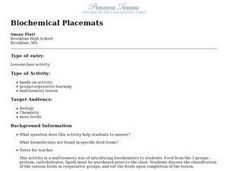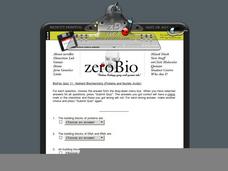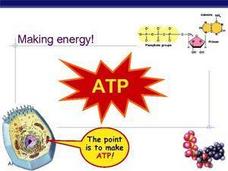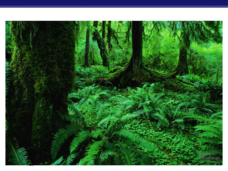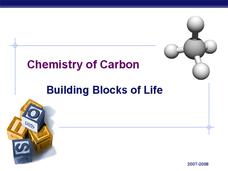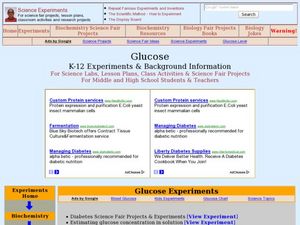Science Geek
Basic Biochemistry - Carbohydrate, Protein and Fat
You are what you eat, right down to your molecular structure. A hearty presentation begins with the two types of carbohydrates, simple and complex. Then it details proteins and amino acids. It ends by reviewing the three types of fats,...
Biology Junction
Biochemistry Crossword
In this biochemistry worksheet, learners complete a crossword puzzle with 36 questions. They identify different polymers and functional groups.
Curated OER
Who Took Jerell's iPod? ~ An Organic Compound Mystery
Within the setting of a crime scene investigation, biochemistry beginners analyze organic compounds as a means of determining "Who dunnit." They use a brown paper test for lipids, glucose test strips and iodine to identify carbohydrates,...
Curated OER
The Four Groups of Biologically Important Compounds
This is not they typical set of teacher instructions. It is an organized chart of the important organic compounds. For each, the involved elements, the name of the building block monomers, the names of polymers, extra information, and a...
Curated OER
Biomolecules
Learners perform an experiment in which they test foods for the presence of proteins, carbohydrates, and lipids. They identify the molecular structure of each type of biomolecule and then discuss how biomolecules relate to nutrition and...
Curated OER
Biochemical Placemats
Students group various foods according to whether they are proteins, carbohydrates, or lipids. This activity is a multisensory way of introducing students to biochemistry. Students also learn how icons represent the molecular composition...
Curated OER
Biochemistry Quiz
In this biochemistry worksheet, students review amino acids, proteins, lipids, and carbohydrates. This worksheet has 29 multiple choice, 8 fill in the blank, and 3 short answer questions.
Curated OER
Testing for Life
Young scholars test for organic molecules to determine if a solution contains once living molecules. For this characteristics of life lesson, students test common liquids for the presence of organic molecules, including starch, protein,...
Curated OER
Chemistry Comes to Life
Although biochemistry of the human body is a vital topic, it doesn't have a chapter dedicated to it in many biology textbooks. If that's the case with your text, you can use this resource as a guide for designing your own lecture and as...
Curated OER
Nucleic Acids
A lively presentation presents general facts and history of nucleic acids in a note-taking format. Every slide contains colorful photos or graphics to illuminate and engage. Biology aces learn about the function and structure of these...
Curated OER
Biochemistry Taboo
Students play a "Biochemistry Taboo" game using their knowledge of Biological chemistry and taboo cards. This lesson can be used as a review or an introduction into concepts covered in Biochemistry and includes a pre-activity worksheet.
Curated OER
BioFax Quiz 11 - Nutrient Biochemistry
Here is a quick online quiz on the basics of the DNA molecule. Biology buffs can choose one of five answers for each of the 10 questions and submit the quiz when they are finished. They receive immediate feedback on their performance,...
Curated OER
Cellular Respiration: Other Metabolites and Control of Respiration
The feedback mechanisms of metabolism of a variety of substances in the human body. Carbohydrates, lipids, amino acids, and their derivatives are explained. The biochemistry required to explain the metabolic balance and feedback controls...
Curated OER
The Point is to Make ATP
Storing and transferring energy is explained here with reference to the fight or flight response, along with the need for activity in times of lowered nutrition. This is a great summary of ATP applications, and after the multiple stages...
Curated OER
Photosynthesis: Life from Light and Air
All aspects of the photosynthesis process, and the way that plants have adapted with specializations are detailed here. The diagrams and info-graphics will be useful to your AP biology class. It could also be used as a review covering...
Curated OER
Photosynthesis:The Calvin Cycle
From the light reaction to the Calvin cycle, this presentation contains information about the various stages of photosynthesis. This is a great supplement to some of the biochemistry-heavy presentations about the specific mechanisms....
Curated OER
Testing for Life
Students discuss food and the food groups and their organic nature. They test 3 different solutions and test for protein, starch and glucose. In addition, they create a master table on the board to collect all the teams results.
Curated OER
Nutrient Biochemistry
In this lipids worksheet, students review the different types of lipids and how lipids are used by the body. This worksheet has 3 drawings and 27 fill in the blank statements.
Curated OER
Chemistry of Carbon - Building Blocks of Life
A great review of the structure and function of carbon-based molecules important to life, especially with relevance to humans. The chemistry behind the combination of polymers and the breakdown of bonds is covered. Valuable content in...
Curated OER
Starch
Students examine the basics of starch and how it is used in food. In this photosynthesis activity students experiment with variables that affect starch production in photosynthesis.
Curated OER
Lipids: Fats and Oils
A fantastic presentation with great images should improve student understanding of lipids and their involvement in the body. The chemistry of different fats, phospholipids, and steroids are explained. Additionally, the specific uses,...
Curated OER
Lipids: Fats and Oils
A fantastic presentation with great images should improve student understanding of lipids and their involvement in the body. The chemistry of different fats, phospholipids, and steroids are explained. Additionally, the specific uses,...
Curated OER
Glucose
Students conduct various experiments on glucose. In this biology lesson, students differentiate the process of diffusion and osmosis. They test different foods for the presence of glucose and starch.
Curated OER
"Mush Lab"
Students use the information they learned from reading food labels to create mush meals. They blend unlikely meals together to form the mush and then evaluate its nutritional value. They examine their own eating habits after the lab is...







